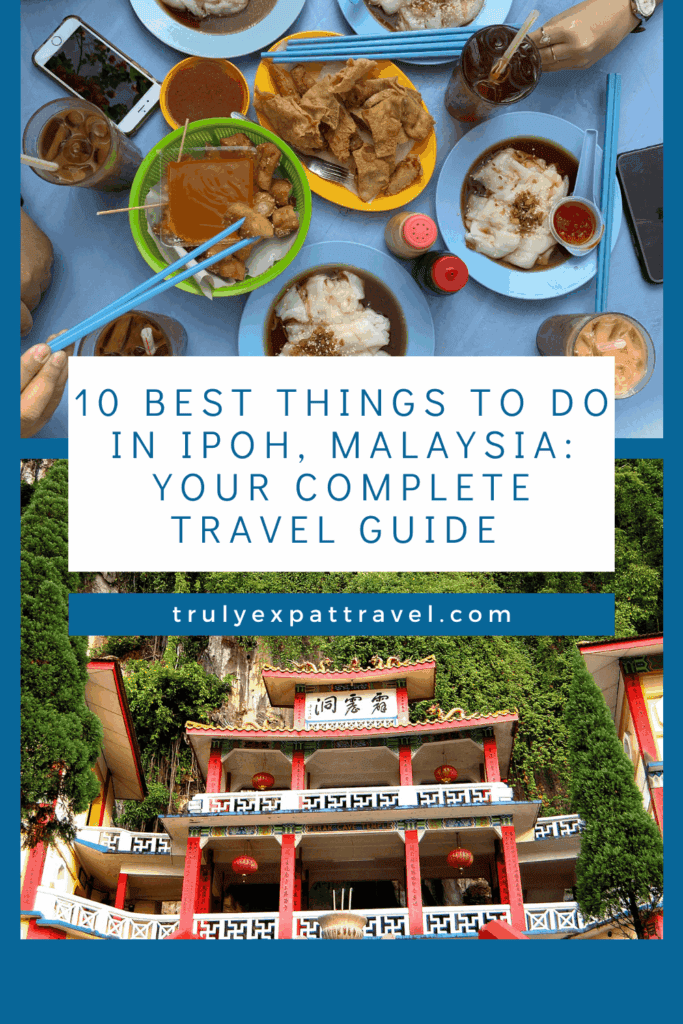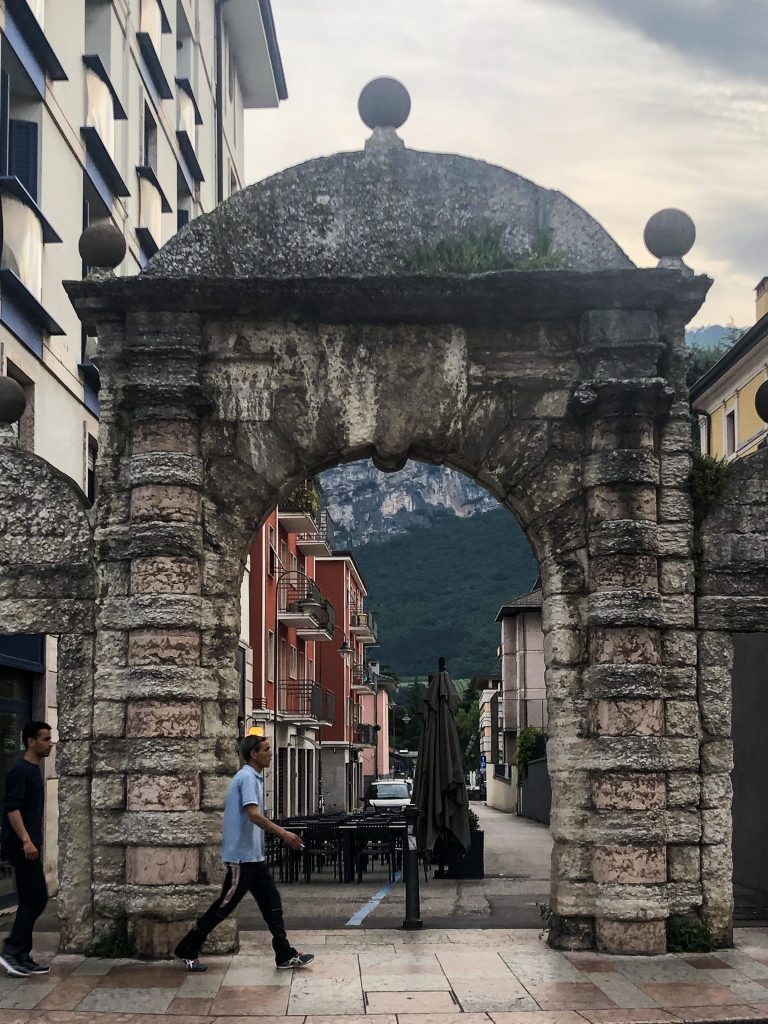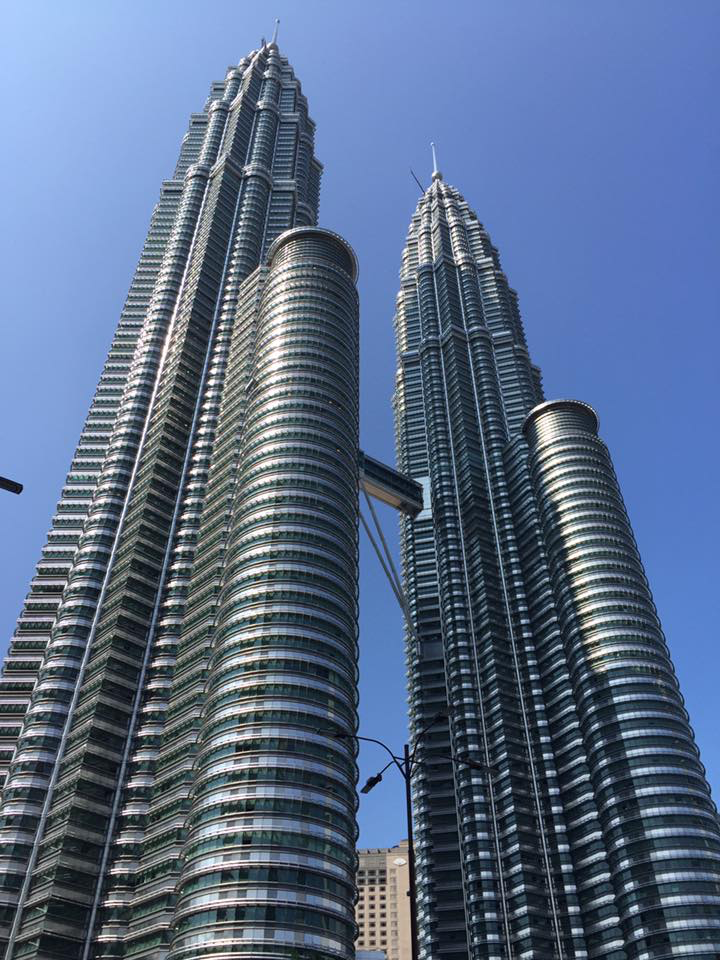
Ipoh gives you everything Penang offers—colonial architecture, street art, incredible food—without the crowds. I’ve spent enough time in both cities to tell you that Ipoh feels more authentic, more relaxed, and honestly, just as rewarding. The limestone karsts create this dramatic backdrop everywhere you look, the coffee culture is unmatched, and you can actually find parking. Here’s what you need to know to make the most of your visit, whether you’re spending a day or a long weekend.
Two full days is ideal. One day covers the main sights—old town, a cave temple, street art, and several excellent meals. Two days lets you explore the Tambun farms, relax at The Banjaran, and really settle into Ipoh’s rhythm. Day trippers from KL or Penang should focus on the old town and one cave temple.
Enjoyed this guide? Running this blog takes a lot of coffee (and time exploring every corner of Singapore!). If you found this helpful and want to support more honest, detailed guides about Singapore, you can buy me a coffee. No pressure though – I’m just happy you’re here and hope you have an amazing time in Singapore! 🙂
What to do in Ipoh
1. Start With White Coffee and Kaya Toast
Skip the early temple rush. In Ipoh, mornings begin properly with white coffee—a local invention where Hainanese immigrants roasted coffee beans in margarine to create a smoother, less bitter brew with caramel notes. Old Town White Coffee on Jalan Bandar Timah is famous but touristy. However do not get confused the most authentic kopitiam where locals gather is Kedai Kopi Sin Yoon Loong (the 1st Ipoh white coffee since 1937) at 15A, Jalan Bandar Timah, 30000 Ipoh, Perak, Malaysia, do not get confused with the one next door! Pair your coffee with kaya toast (coconut jam and butter on toasted bread). It’s simple, it’s perfect, and it sets the tone for your day.
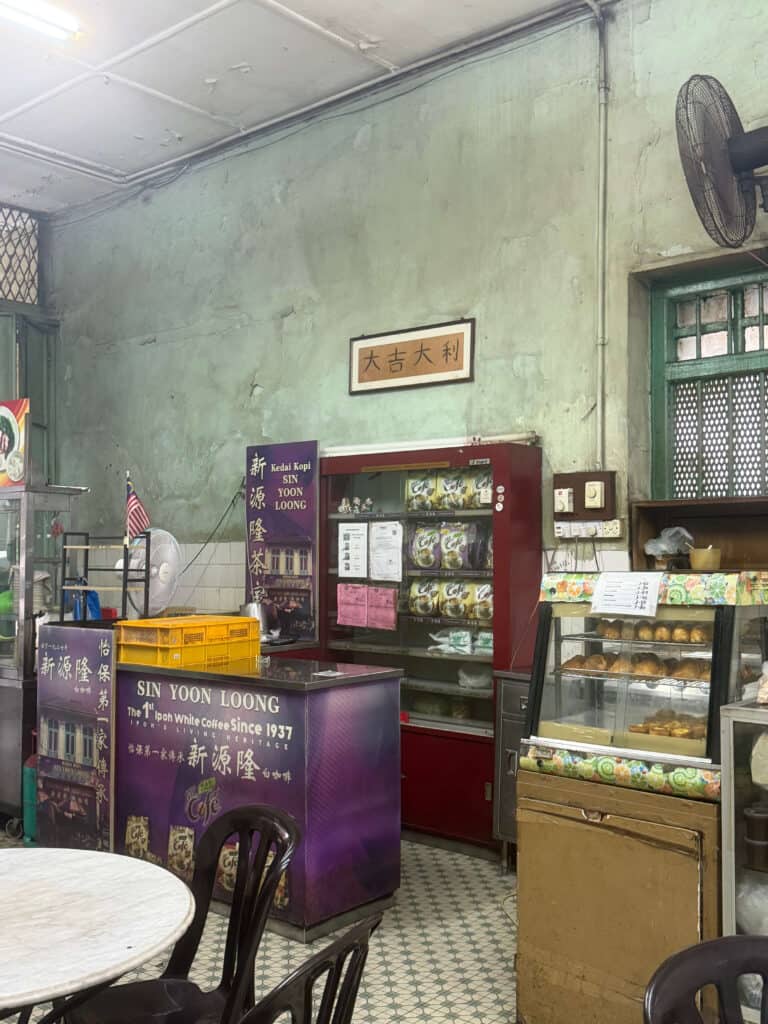
2. Hunt for Street Art at Your Own Pace
Ernest Zacharevic (yes, the Penang murals artist) worked in Ipoh too. His pieces around Mural Art’s Lane and the old town depict trishaws, children playing, and old Ipoh life. The difference from Penang? You won’t queue for photos. You’ll often have the street to yourself. The art quality matches Penang’s, but the experience is far more pleasant. Don’t just tick off the famous pieces—wander side streets where locals and curious travellers find the best murals.

3. Eat Dim Sum at Foh San Restaurant
Restaurant Foh San might serve Malaysia’s best dim sum. The system confuses first-timers: grab a table, order tea, then approach the counters displaying steaming baskets. Point to what looks good (or follow what locals choose), and everything gets marked on your docket. It opens at 6am. By 9am it’s packed. The atmosphere is purely local—families gathering, newspapers being read, pots of tea being refilled. This is what authentic travel actually looks like.
4.Visit Perak Cave Temple (Perak Tong)
Perak Cave Temple, founded in 1926, is Ipoh’s most famous cave temple and absolutely worth visiting. As you approach, you’ll walk through gardens with ornamental pools before reaching the impressive red and white facade nestled against limestone cliffs. Inside, the massive cavern houses a 40-foot golden Buddha flanked by four guardian deities, with vibrant murals depicting Buddhist teachings and Chinese calligraphy covering the walls.
The real highlight? Taking the 450-step challenge to the summit for panoramic views across Ipoh. The stairs pass through low-headroom areas and get steep, but the views justify the effort. You’ll see the karst landscape that defines Ipoh (though the industrial estate below isn’t particularly scenic). Visit early morning (8-9am) when it’s cooler—weekdays are quieter than weekends. Entry is free, though donations are appreciated. Special note: Sam Poh Tong Cave Temple was closed at the time I visited
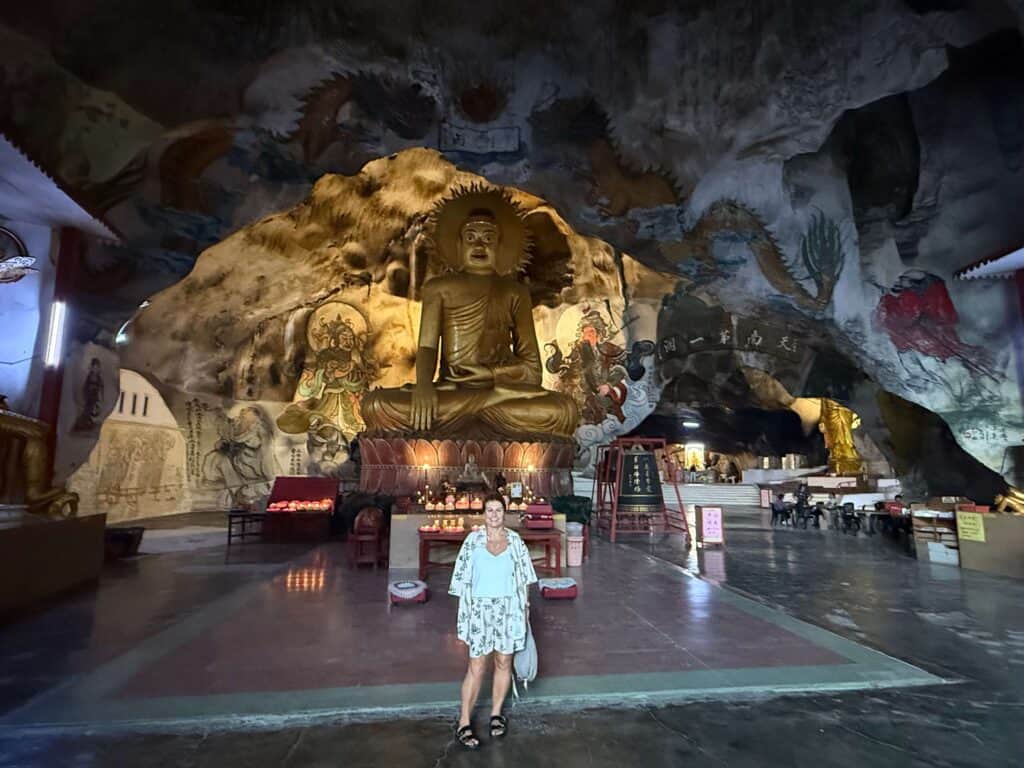
5. Explore Concubine Lane and Market
Every guide mentions wealthy tin barons housing mistresses here. Whether true or tourist legend, today Concubine Lane (and its neighbours, Market Lane and Wife Lane) buzz with small shops, cafés, and weekend market stalls. It’s touristy but worth an hour. Look for What to Wear (Malaysian-designed clothing) and craft shops selling genuinely local products rather than mass-produced souvenirs.

6. Walk the Heritage Trail
Ipoh’s colonial architecture tells the story of tin wealth—so much that it was once called “City of Millionaires.” The Heritage Trail takes you past the train station (stunning Moorish revival architecture), the Town Hall, the High Court, and dozens of beautifully weathered shophouses. Ipoh’s old town is small enough to explore intuitively. Grab a coffee, look up at the buildings, duck down interesting alleyways. The joy is discovering your own favourite corners.
7. Visit Ho Yan Hor Museum
Located right across from Concubine Lane, this free museum tells the story of Malaysia’s most trusted herbal tea brand, founded by Dr. Ho Kai Cheong in 1941. The museum occupies the original two-storey shophouse where he started his business during the tin mining era, complete with 100-year-old staircases and a preserved traditional kitchen.
The 30-minute self-guided tour takes you through Dr. Ho’s journey from Chinese physician to successful entrepreneur. You’ll see original documents handwritten by him, antiques from the business, and learn about the 24 herbal ingredients in his famous flu remedy (though five remain a mystery). The building itself is beautifully restored with interpretive boards in English, Chinese, and Malay.
At the end, staff serve complimentary tastings of four to six herbal tea varieties—refreshing, aromatic, and perfect for relieving body heat. There’s no hard selling, though you can purchase teas at the museum if you’d like. I bought 2 types myself!
Important: Book ahead via WhatsApp (+60 12-248 4517) or phone (+60 5-2412048) to reserve your time slot, as they limit groups to 20 people for safety and crowd control. Tours run from 10am to 4pm Tuesday through Sunday (closed Mondays). Walk-ins are possible before 10am if not fully booked, but weekends fill quickly. The museum is air-conditioned—a welcome break from Ipoh’s heat.
8. Discover Tambun’s Fruit Farms
Just outside Ipoh, Tambun offers a unique agritourism experience at two neighbouring farms. Tambun Musk Melon Agro Farm is Malaysia’s largest Japanese musk melon plantation. The free guided tours take you through greenhouses where you’ll learn how they grow these premium melons in tropical conditions—each plant produces just one fruit in its 70-day lifetime. You can taste freshly cut melon and buy whole ones at better prices than supermarkets. Ask for Steven, I learnt so much about the Japanese style of farming, the delicate fruits and vegetables that are grown there, as he shows you around the farm.
Right across the road, GoChin Pomelo Agro Farm has been growing pomelos for over 20 years on 7.3 hectares. Entry is free. Walk under mature pomelo trees, see fruit at different growth stages, and try other tropical fruits like custard apple and guava. The limestone-rich soil produces particularly sweet pomelos. Both farms sell fresh juice and fruit to take away. Visit early morning to avoid the heat—the musk melon greenhouses can reach 50°C in summer.
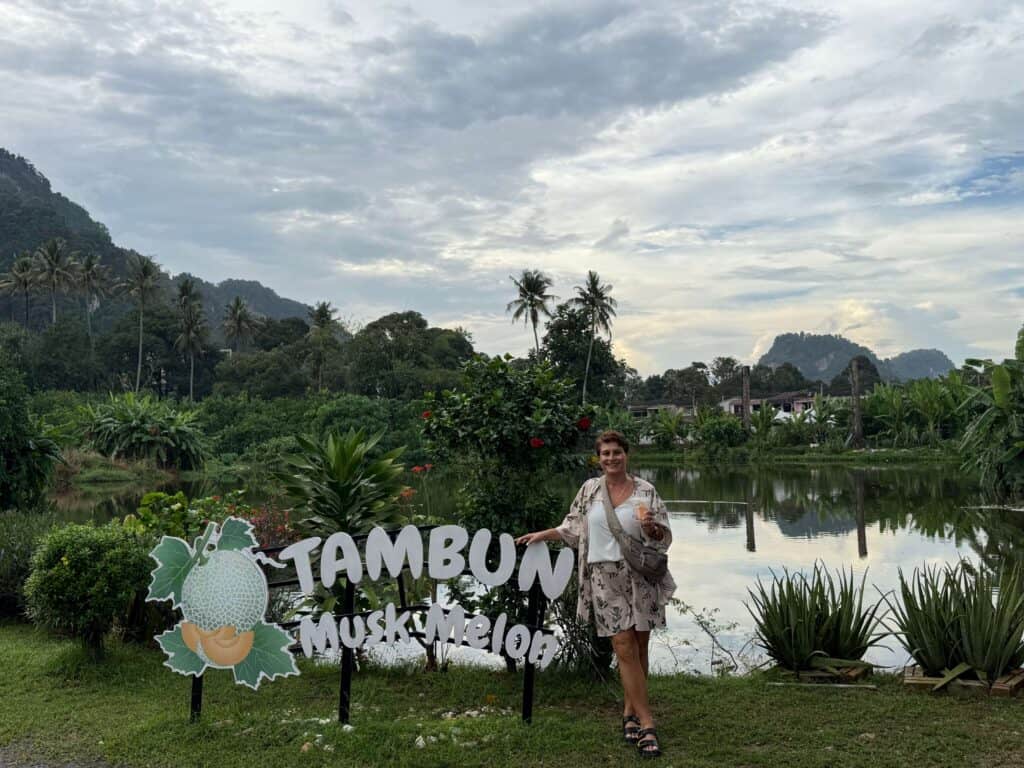
9. Experience The Banjaran Hotsprings Retreat
If you’re not staying overnight at this luxury resort (villas start at RM1,850), the day pass offers exceptional value. Book through klook (around $100-106 SGD per person) for access from 10am-7pm to geothermal hot springs dipping pools, thermal steam cave, ice bath, meditation cave, Crystal Cave, doctor fish pool, fitness centre, and swimming pool. The day pass includes RM150 credit for spa treatments or lunch at Pomelo Restaurant.
The setting is spectacular—260-million-year-old limestone cliffs, cascading waterfalls, and three million litres of geothermal water that billow up daily from underground. The hot spring tubs overlook a beautiful lake, and you’ll likely get one to yourself. Bring your own swimwear; lockers, bathrobes, towels, and shower facilities are provided. Note: only guests aged 12 and above are permitted.
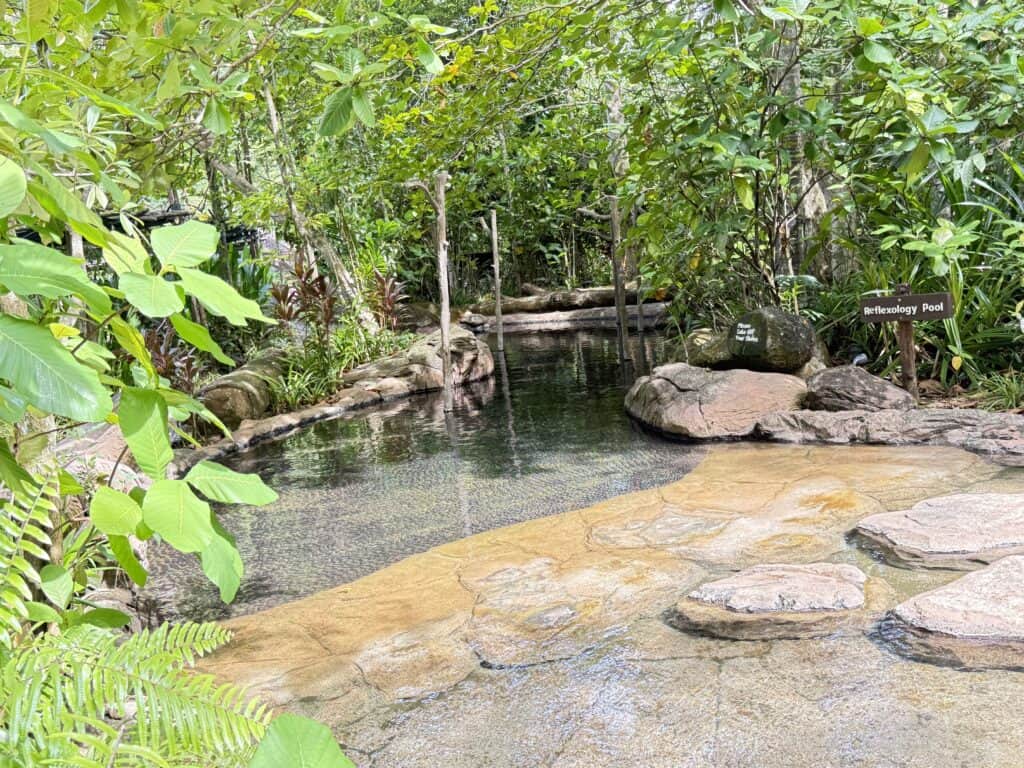
10. Try Ipoh’s Legendary Food
Beyond white coffee and dim sum, try tauge ayam (poached chicken with bean sprouts—Lou Wong is famous), salt-baked chicken, Ipoh hor fun (flat rice noodles in clear soup), and curry mee. The food isn’t fancy or Instagrammable. You’ll often eat on plastic stools in un-air-conditioned spaces. But it’s some of the most flavourful, well-prepared food in Malaysia. Trust local recommendations, eat where you see queues, and don’t worry about finding “the best” place—they’re all good.
Getting to Ipoh
From Singapore: You have three main options:
By Flight (Fastest): Direct flights from Changi Airport to Sultan Azlan Shah Airport take 1 hour 10 minutes. Scoot and Batik Air (new route) operate this route, with prices ranging from SGD 70-100 one-way. The catch? Limited flight schedules, so book early especially during weekends and holidays. From Ipoh airport, it’s only 6km to the city centre—a Grab costs under RM20. Total journey time including airport procedures: about 4-5 hours.
By Bus (Most Economical): Direct buses from Golden Mile Complex or other Singapore terminals take 8-12 hours depending on border crossing times. StarMart Express, Sri Maju, and Super Nice Express operate this route, with tickets from SGD 30-40. Buses are comfortable with reclining seats and air-conditioning (bring a jumper—it gets cold). You’ll stop at both Singapore and Malaysian checkpoints for immigration. Pro tip: Avoid peak travel times (Friday evenings, holiday weekends) to reduce border delays.
By Private Car: A private driver costs around SGD 400-600 for the 6-7 hour journey via Johor. This works well if you’re travelling with a group or want to stop at Malacca or other towns en route. Book through
From Kuala Lumpur: Train from KL Sentral takes 2.5-3 hours, costs under $10 USD. It’s comfortable, runs frequently, and drops you right in town. Book through
From Penang: Ferry to Butterworth, then bus or train (1.45 hours). [12Go Asia] handles bookings easily.
From Cameron Highlands: Buses run regularly (3 hours).
Klook.comPractical Tips
- Weather: Hot and humid year-round. Plan activities for early morning and late afternoon, leaving midday for lunch and rest.
- Walking: Old town is flat and walkable. Cave temples require climbing—stairs are steep but manageable if you’re reasonably fit.
- Transport: Walk within old town. Use Grab for temples and outlying attractions. It’s cheap and eliminates taxi fare negotiations.
- Cash: Many kopitiams and market stalls are cash only. ATMs are plentiful.
Is Ipoh Worth Visiting?
Absolutely—especially if you appreciate authentic local experiences over tourist hotspots. Ipoh gives you cultural attractions, excellent food, interesting architecture, and beautiful natural settings without the crowds. Whether breaking your journey between KL and Penang or making a dedicated trip, give Ipoh two days. You’ll understand why expats treasure this understated city.
Get Travel Insurance QuoteFrequently Asked Questions About Ipoh
Is Ipoh safe for solo travellers?
Yes, very much so. Ipoh is genuinely safe with friendly locals. The usual sensible precautions apply (don’t flash valuables, know where you’re going), but it feels safer than many Western cities. Malaysian culture is respectful, and you’ll find people helpful rather than pushy.
Can you see Ipoh on a day trip, or should you stay overnight?
You can cover main highlights—old town, one cave temple, street art, and meals—in a long day trip from KL or Penang. But staying overnight lets you experience Ipoh’s rhythm: early morning dim sum, evening strolls when the heat breaks, the slower pace. If your schedule allows, stay two nights.
What’s the best way to visit cave temples without a car?
Grab is cheap and reliable. From old town to Sam Poh Tong costs about 15-20 ringgit ($3-4 USD) and takes 15 minutes. Many hotels arrange drivers for temple circuits (2-3 hours visiting multiple temples) for around 100-150 ringgit. For freedom and cost-effectiveness, use Grab—call one when you’re ready to leave.
How does Ipoh compare to Penang?
Both are excellent but different. Penang (Georgetown) is more developed for tourism—better restaurant variety, more nightlife, busier streets. Ipoh is quieter, less international, more authentically Malaysian. Want polished tourism infrastructure? Choose Penang. Prefer discovering places before everyone else arrives? Choose Ipoh. They’re only two hours apart—do both if you can.
What’s included in The Banjaran day pass?
The day pass (book through Klook) gives 10am-7pm access to geothermal hot springs, thermal steam cave, ice bath, meditation cave, Crystal Cave, doctor fish pool, fitness centre, and swimming pool. It includes RM150 credit for spa treatments or food at Pomelo Restaurant. Bring your own swimwear; lockers, bathrobes, and towels are provided. Only guests aged 12+ are permitted.
Your Ipoh Journey Starts Here
Ipoh rewards curious travellers who appreciate authenticity over Instagram moments. Coffee shops serve locals first and tourists second. Temple caves remain places of worship, not just photo opportunities. “Slow travel” isn’t a marketing term—it’s simply how life unfolds here.
Before your trip, sort the practical bits: book accommodation in old town, arrange travel insurance through SafetyWings, and pre-book The Banjaran day pass and any tours through Klook. Then relax into the experience. Ipoh doesn’t require rigid planning—it’s best discovered by following your instincts, local recommendations, and the smell of good coffee.
Stay Connected
Follow along on Instagram where I share real-time travel updates, behind-the-scenes moments from tours, and daily life in Singapore.
Join the Truly Expat Facebook community—a supportive space for women travellers to ask questions, share tips, and connect before trips.
Affiliate Disclosure: This post contains affiliate links. If you book through them, I may earn a small commission at no extra cost to you—this helps me keep creating free, detailed travel guides. I only recommend services and products I genuinely use and trust after years of travel across Asia.
Pin It for Later
